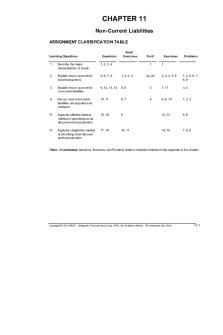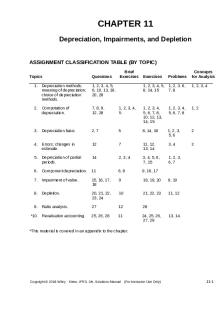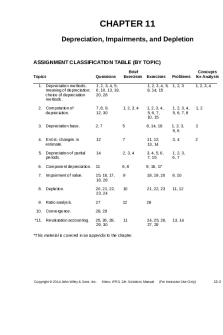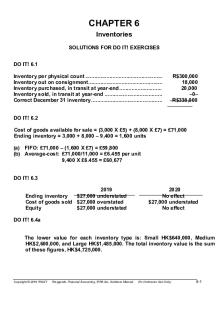Financial Accounting Ch11 Solution PDF

| Title | Financial Accounting Ch11 Solution |
|---|---|
| Author | Hh j |
| Course | Financial Accounting |
| Institution | 연세대학교 |
| Pages | 48 |
| File Size | 836.6 KB |
| File Type | |
| Total Downloads | 489 |
| Total Views | 585 |
Summary
Copyright © 2019 WILEY Weygandt, Financial Accounting , IFRS , 4/e, Solutions Manual (For Instructor Use Only) 11-CHAPTER 11Non-Current LiabilitiesASSIGNMENT CLASSIFICATION TABLELearning Objectives QuestionsBrief Exercises Do It! Exercises Problems Describe the major characteristics of bonds. 1, 2, ...
Description
CHAPTER 11 Non-Current Liabilities ASSIGNMENT CLASSIFICATION TABLE
Learning Objectives
Brief Exercises
Questions
1.
Describe the major characteristics of bonds.
1, 2, 3, 4
2.
Explain how to account for bond transactions.
5, 6, 7, 8
1, 2, 3, 4
3.
Explain how to account for non-current liabilities.
9, 12, 13, 14
5, 8
4.
Discuss how non-current liabilities are reported and analyzed.
10, 11
6, 7
*5.
Apply the effective-interest method of amortizing bond discount and bond premium.
15, 16
*6.
Apply the straight-line method of amortizing bond discount and bond premium.
17, 18
Exercises
Do It! 1
2a, 2b
Problems
1
2, 3, 4, 5, 6
1, 2, 5, 6, 7, 8, 9
3
7, 11
3, 4
4
8, 9, 10
1, 2, 3
9
12, 13
5, 6
10, 11
14, 15
7, 8, 9
*Note: All asterisked Questions, Exercises, and Problems relate to material contained in the appendix to the chapter.
Copyright © 2019 WILEY Weygandt, Financial Accounting, IFRS, 4/e, Solutions Manual (For Instructor Use Only)
11-1
ASSIGNMENT CHARACTERISTICS TABLE Problem Number
11-2
Description
Difficulty Level
Time Allotted (min.)
1
Prepare entries to record issuance of bonds, interest accrual, and bond redemption.
Moderate
20–30
2
Prepare entries to record issuance of bonds, interest accrual, and bond redemption.
Moderate
15–20
3
Prepare installment payments schedule and journal entries for a mortgage note payable.
Moderate
20–30
4
Analyze two different lease situations and prepare journal entries.
Moderate
20–30
*5
Prepare entries to record issuance of bonds, payment of interest, and amortization of bond discount using effective-interest method.
Moderate
30–40
*6
Prepare journal entries to record issuance of bonds, payment of interest, and effective-interest amortization, and statement of financial position presentation.
Moderate
30–40
*7
Prepare entries to record issuance of bonds, interest accrual, and straight-line amortization for two years.
Simple
30–40
*8
Prepare entries to record issuance of bonds, interest, and straight-line amortization of bond premium and discount.
Simple
30–40
*9
Prepare entries to record interest payments, straight-line premium amortization, and redemption of bonds.
Moderate
30–40
Copyright © 2019 WILEY Weygandt, Financial Accounting, IFRS, 4/e, Solutions Manual (For Instructor Use Only)
WEYGANDT FINANCIAL ACCOUNTING IFRS, 4E CHAPTER 11 NON-CURRENT LIABILITIES
Number
LO
BT
Difficulty
Time (min.)
BE1
2
AP
Simple
4–6
BE2
2
AP
Simple
3–5
BE3
2
AP
Simple
4–6
BE4
2
AP
Simple
3–5
BE5
3
AP
Simple
6–8
BE6
4
AP
Simple
3–5
BE7
4
AP
Simple
6–8
BE8
3
AP
Simple
2–3
*BE9
5
AP
Simple
4–6
*BE10
6
AP
Simple
4–6
*BE11
6
AP
Simple
4–6
DI1
1
C
Simple
2–3
DI2a
2
AP
Simple
4–6
DI2b
2
AP
Simple
3–5
DI3
3
AP
Simple
4–6
DI4
3
AP
Simple
4–6
EX1
1
C
Simple
4–6
EX2
2
AP
Simple
4–6
EX3
2
AP
Simple
4–6
EX4
2
AP
Simple
5–7
EX5
2
AP
Moderate
8–10
EX6
2
AP
Simple
6–8
EX7
3
AP
Simple
6–8
EX8
4
AP
Simple
3–5
EX9
4
AP
Simple
4–6
EX10
4
AN
Simple
4–6
EX11
3
AP
Simple
4–6
Copyright © 2019 WILEY Weygandt, Financial Accounting, IFRS, 4/e, Solutions Manual (For Instructor Use Only)
11-3
LONG-TERM LIABILITIES (Continued) Number
LO
BT
Difficulty
Time (min.)
*EX12
5
AP
Moderate
8–10
*EX13
5
AP
Moderate
8–10
*EX14
6
AP
Simple
6–8
*EX15
6
AP
Simple
6–8
P1
2, 4
AP
Moderate
20–30
P2
2, 4
AP
Moderate
15–20
P3
3, 4
AP
Moderate
20–30
P4
3
AP
Moderate
20–30
*P5
2, 5
AP
Moderate
30–40
*P6
2, 5
AP
Moderate
30–40
*P7
2, 6
AP
Simple
30–40
*P8
2, 6
AP
Simple
30–40
*P9
2, 6
AP
Moderate
30–40
CT1
4
AN
Simple
5–10
CT2
4
AP
Simple
10–15
CT3
4
C
Simple
10–15
CT4
1
AN
Simple
10–15
CT5
1
C
Moderate
15–20
CT6
1
E
Simple
10–15
11-4
Copyright © 2019 WILEY Weygandt, Financial Accounting, IFRS, 4/e, Solutions Manual (For Instructor Use Only)
Learning Objective
Knowledge
1. Describe the major characteristics of bonds. 2. Explain how to account for bond transactions.
Q11.5
3. Explain how to account for noncurrent liabilities.
Q11.12
Comprehension Q11.1 Q11.2 Q11.3 Q11.6 Q11.8
Application
Analysis
Synthesis
Evaluation
Q11.4 DI11.1 E11.1 Q11.7 BE11.1 BE11.2 BE11.3 BE11.4 DI11.2a DI11.2b
E11.2 E11.3 E11.4 E11.5 E11.6
P11.1 P11.2 P11.5 P11.6 P11.7 P11.8 P11.9
Q11.9 Q11.13 Q11.14
BE11.5 BE11.8 DI11.3
E11.7 E11.11
P11.3 P11.4
4. Discuss how non-current liabilities are reported and analyzed.
Q11.10 Q11.11
BE11.6 BE11.7 DI11.4 E11.8 E11.9 P11.1
P11.2 P11.3
*5. Apply the effective-interest method of amortizing bond discount and bond premium. *6. Apply the straight-line method of amortizing bond discount and bond premium.
Q11.15 Q11.16
BE11.9 E11.12 E11.13 BE11.10 BE11.11 E11.14 E11.15
P11.5 P11.6
Expand Your Critical Thinking
Communication Real-World Focus
Q11.17 Q11.18
BLOOM’S TAXONOMY TABLE
Copyright © 2019 WILEY Weygandt, Financial Accounting, IFRS, 4/e, Solutions Manual (For Instructor Use Only)
Correlation Chart between Bloom’s Taxonomy, Learning Objectives and End-of-Chapter Exercises and Problems
E11.10
P11.7 P11.8 P11.9
Comp. Analysis
Financial Reporting Decision Making Across the Organization
Ethics Case
11-5
ANSWERS TO QUESTIONS 1. (a) Non-current liabilities are obligations that are expected to be paid after one year. Examples include bonds, long-term notes, and lease obligations. (b) Bonds are a form of interest-bearing notes payable used by corporations, universities, and governmental agencies. 2. (a) Secured bonds have specific assets of the issuer pledged as collateral. In contrast, unsecured bonds are issued against the general credit of the borrower. These bonds are called debenture bonds. (b) Convertible bonds may be converted into ordinary shares at the bondholders’ option. In contrast, callable bonds are subject to call and retirement at a stated currency amount prior to maturity at the option of the issuer. 3. (a) Face value is the amount of principal due at the maturity date. (Face value is also called par value.) (b) The contractual interest rate is the rate used to determine the amount of cash interest the borrower pays and the investor receives. This rate is also called the stated interest rate because it is the rate stated on the bonds. (c) A bond indenture is a legal document that sets forth the terms of the bond issue. (d) A bond certificate is a legal document that indicates the name of the issuer, the face value of the bonds, and such other data as the contractual interest rate and maturity date of the bonds. 4. The two major obligations incurred by a company when bonds are issued are the interest payments due on a periodic basis and the principal which must be paid at maturity. 5. Less than. Investors are required to pay more than the face value; therefore, the market interest rate is less than the contractual rate. 6. R$48,000. R$800,000 X 6% = R$48,000. 7. HK$9,000,000. The balance of the Bonds Payable account plus the unamortized bond discount (or minus the unamortized bond premium) equals the face value of the bonds. 8 Debits: Credits:
Bonds Payable (for the carrying value of the bonds). Cash (for 97% of the face value) and Gain on Bond Redemption (for the difference between the cash paid and the bonds’ carrying value).
9. No, Roy is not right. Each payment by Roy consists of: (1) interest on the unpaid balance of the loan and (2) a reduction of loan principal. The interest decreases each period while the portion applied to the loan principal increases each period. 10. The nature and the amount of each non-current liability should be presented in the statement of financial position or in schedules in the accompanying notes to the statements. The notes should also indicate the interest rates, maturity dates, conversion privileges, and assets pledged as collateral. 11. (a) The major advantages are: (1) Shareholder control is not affected—bondholders do not have voting rights, so current shareholders retain full control of the company.
11-6
Copyright © 2019 WILEY Weygandt, Financial Accounting, IFRS, 4/e, Solutions Manual (For Instructor Use Only)
Questions Chapter 11 (Continued) (2) Tax savings result—in some countries bond interest is deductible for tax purposes; dividends on stock are not. (3) Earnings per share may be higher—although bond interest expense will reduce net income, earnings per share on ordinary shares will often be higher under bond financing because no additional shares are issued. (b) The major disadvantages in using bonds are that interest must be paid on a periodic basis and the principal (face value) of the bonds must be paid at maturity. 12.
A lease agreement is a contract in which the lessor gives the lessee the right to use an asset for a specified period in return for one or more periodic rental payments. The lessor is the owner of the property and the lessee is the renter or tenant.
13.
Jhutti would recognize a lease liability and a right-of-use asset in its records and on the statement of financial position.
14.
In this lease agreement, the lessee records the present value of the lease payments as an asset and a liability. Therefore, Benedict Production would debit Right-of-Use Asset for $186,300 and credit Lease Liability for the same amount.
*15. Ginny is probably indicating that since the borrower has the use of the bond proceeds over the term of the bonds, the borrowing rate in each period should be the same. The effective-interest method results in a varying amount of interest expense but a constant rate of interest on the balance outstanding. Accordingly, it results in a better matching of expenses with revenues than the straight-line method. *16. Decrease. Under the effective-interest method the interest charge per period is determined by multiplying the carrying value of the bonds by the effective-interest rate. When bonds are issued at a premium, the carrying value decreases over the life of the bonds. As a result, the interest expense will also decrease over the life of the bonds because it is determined by multiplying the decreasing carrying value of the bonds at the beginning of the period by the effective-interest rate. *17. The straight-line method results in the same amortized amount being assigned to Interest Expense each interest period. This amount is determined by dividing the total bond discount or premium by the number of interest periods the bonds will be outstanding. *18. £24,000. Interest expense is the interest to be paid in cash less the premium amortization for the year. Cash to be paid equals 7% X £400,000 or £28,000. Total premium equals 5% of £400,000 or £20,000. Since this is to be amortized over 5 years (the life of the bonds) in equal amounts, the amortization amount is £20,000 ÷ 5 = £4,000. Thus, £28,000 – £4,000 or £24,000 equals interest expense for 2020.
Copyright © 2019 WILEY Weygandt, Financial Accounting, IFRS, 4/e, Solutions Manual (For Instructor Use Only)
11-7
SOLUTIONS TO BRIEF EXERCISES BRIEF EXERCISE 11.1 2020 (a) Jan. 1
(b) Dec. 31
2021 (c) Jan. 1
Cash................................................. Bonds Payable (4,000 X £1,000) ...................
4,000,000
Interest Expense ............................. Interest Payable (£4,000,000 X 8%) .................
320,000
Interest Payable .............................. Cash .........................................
320,000
4,000,000
320,000
320,000
BRIEF EXERCISE 11.2 (a) Jan. 1 (b) Jan. 1
Cash (€2,000,000 X .97) .................. Bonds Payable ........................
1,940,000
Cash (€2,000,000 X 1.04) ................ Bonds Payable ........................
2,080,000
1,940,000 2,080,000
BRIEF EXERCISE 11.3 1.
2. 3.
11-8
Jan. 1
July 1 Sept. 1
Cash (1,000 X €1,000) ..................... Bonds Payable ........................
1,000,000
Cash (€900,000 X 1.02) ................... Bonds Payable ........................
918,000
Cash (€400,000 X .98) ..................... Bonds Payable ........................
392,000
1,000,000
918,000 392,000
Copyright © 2019 WILEY Weygandt, Financial Accounting, IFRS, 4/e, Solutions Manual (For Instructor Use Only)
BRIEF EXERCISE 11.4 Bonds Payable ........................................................ Loss on Bond Redemption (£1,010,000 – £940,000) ....................................... Cash (£1,000,000 X 101%) ...............................
940,000 70,000 1,010,000
BRIEF EXERCISE 11.5 (A) Annual Interest Period Issue Date 1 Dec. 31, 2020 Dec. 31, 2021
Cash Payment
(B) Interest Expense (D) X 10%
(C) Reduction of Principal (A) – (B)
£130,196
£80,000
£50,196
(D) Principal Balance (D) – (C) £800,000 749,804
Cash ..................................................... Mortgage Payable ..........................
800,000
Interest Expense ................................. Mortgage Payable................................ Cash ...............................................
80,000 50,196
800,000
130,196
BRIEF EXERCISE 11.6 Non-current liabilities Bonds payable, due 2022 ...................................... Notes payable, due 2025 ....................................... Lease liability ......................................................... Total non-current liabilities ...........................
Copyright © 2019 WILEY Weygandt, Financial Accounting, IFRS, 4/e, Solutions Manual (For Instructor Use Only)
CHF500,000 80,000 72,000 CHF652,000
11-9
BRIEF EXERCISE 11.7 Income before interest and taxes Interest (€2,000,000 X 6%) Income before income taxes Income tax expense (30%) Net income (a) Outstanding shares (b) Earnings per share (a) ÷ (b)
Issue Shares €900,000 0 900,000 270,000 €630,000
Issue Bond €900,000 120,000 780,000 234,000 €546,000
700,000 €0.90
500,000 €1.09
Net income is higher if shares are used. However, earnings per share is lower than earnings per share if bonds are used because of the additional shares that are outstanding. BRIEF EXERCISE 11.8 Right-of-Use Asset................................................. Lease Liability ................................................
700,000 700,000
*BRIEF EXERCISE 11.9 (a) Interest Expense .................................................... Bonds Payable ............................................... Cash ................................................................
48,070 3,070 45,000
(b) Interest expense is greater than interest paid because the bonds sold at a discount which must be amortized over the life of the bonds. The bonds sold at a discount because investors demanded a market interest rate higher than the contractual interest rate. (c) Interest expense increases each period because the bond carrying value increases each period. As the market interest rate is applied to this bond carrying amount, interest expense will increase.
11-10
Copyright © 2019 WILEY Weygandt, Financial Accounting, IFRS, 4/e, Solutions Manual (For Instructor Use Only)
Similar Free PDFs

Financial Accounting Ch11 Solution
- 48 Pages

Ch11 - Solution manual ch11
- 83 Pages

Ch11 - accounting
- 49 Pages

solution manual - Ch11
- 84 Pages

Ch11 - intermediate accounting
- 40 Pages
Popular Institutions
- Tinajero National High School - Annex
- Politeknik Caltex Riau
- Yokohama City University
- SGT University
- University of Al-Qadisiyah
- Divine Word College of Vigan
- Techniek College Rotterdam
- Universidade de Santiago
- Universiti Teknologi MARA Cawangan Johor Kampus Pasir Gudang
- Poltekkes Kemenkes Yogyakarta
- Baguio City National High School
- Colegio san marcos
- preparatoria uno
- Centro de Bachillerato Tecnológico Industrial y de Servicios No. 107
- Dalian Maritime University
- Quang Trung Secondary School
- Colegio Tecnológico en Informática
- Corporación Regional de Educación Superior
- Grupo CEDVA
- Dar Al Uloom University
- Centro de Estudios Preuniversitarios de la Universidad Nacional de Ingeniería
- 上智大学
- Aakash International School, Nuna Majara
- San Felipe Neri Catholic School
- Kang Chiao International School - New Taipei City
- Misamis Occidental National High School
- Institución Educativa Escuela Normal Juan Ladrilleros
- Kolehiyo ng Pantukan
- Batanes State College
- Instituto Continental
- Sekolah Menengah Kejuruan Kesehatan Kaltara (Tarakan)
- Colegio de La Inmaculada Concepcion - Cebu










